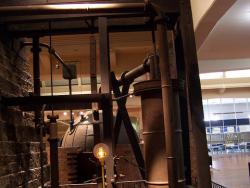The La Esperanza sugar mill steam engine is one of the few remaining American links to the pioneer beam engines of the English inventors Thomas Newcomen (1712) and James Watt (1769). The engine was built in 1861 in Cold Spring, New York, by the West Point Foundry. The general arrangement and details, including the Gothic embellishment, are typical of machinery of the period. The straight-line motion of the piston rod is accommodated to the arc of the moving beam end by a parallel motion. Watt regarded this ingenious linkage as the invention of which he was most proud.
Newcomen, Thomas


The unprecedented innovation of the steam-atmospheric engine by Thomas Newcomen (1663-1729) of Dartmouth and his assistant John Calley stands at the beginning of the development of practical thermal prime movers in the early years of the eighteenth century. Spreading through Europe and then to the Cornwall mines in the New World, it was one of the strategic innovations in world history and the single greatest act of synthesis in the ensuing history of the steam engine.

The unprecedented innovation of the steam-atmospheric engine by Thomas Newcomen (1663-1729) of Dartmouth and his assistant John Calley stands at the beginning of the development of practical thermal prime movers in the early years of the eighteenth century. Spreading through Europe and then to…
Read More
The La Esperanza sugar mill steam engine is one of the few remaining American links to the pioneer beam engines of the English inventors Thomas Newcomen (1712) and James Watt (1769). The engine was built in 1861 in Cold Spring, New York, by the West Point Foundry. The general arrangement and…
Read More

